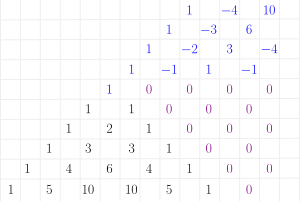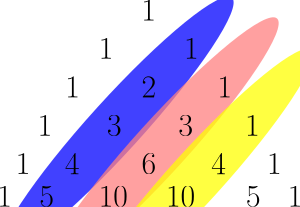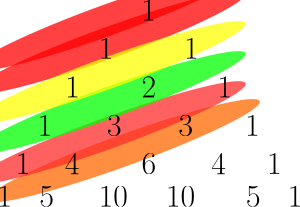Introduction Binomial expansion
(
a
+
b
)
0
=
1
(
a
+
b
)
1
=
a
+
b
(
a
+
b
)
2
=
a
2
+
2
a
b
+
b
2
(
a
+
b
)
3
=
(
a
+
b
)
(
a
+
b
)
2
=
(
a
+
b
)
(
a
2
+
2
a
b
+
b
2
)
=
a
3
+
2
a
2
b
+
a
b
2
+
b
a
2
+
2
a
b
2
+
b
3
=
a
3
+
3
a
2
b
+
3
a
b
2
+
b
3
(
a
+
b
)
4
=
⋯
{\displaystyle {\begin{aligned}(a+b)^{0}&=1\\(a+b)^{1}&=a+b\\(a+b)^{2}&=a^{2}+2ab+b^{2}\\(a+b)^{3}&=(a+b)(a+b)^{2}=(a+b)(a^{2}+2ab+b^{2})\\&=a^{3}+2a^{2}b+ab^{2}+ba^{2}+2ab^{2}+b^{3}\\&=a^{3}+3a^{2}b+3ab^{2}+b^{3}\\(a+b)^{4}&=\cdots \end{aligned}}}
Pascal's triangle Pascal's Triangle The coefficients of binomial expansion can be easily seen from the Pascal triangle. The number is a sum of the two numbers above it.
Pascal's triangle: Negative right This can be extended to negative numbers easily.
Pascal triangle extended to negative values Now, instead of expanding
(
a
+
b
)
n
{\displaystyle (a+b)^{n}}
(
1
+
x
)
n
{\displaystyle (1+x)^{n}}
n
{\displaystyle n}
(
1
+
x
)
−
1
=
1
−
x
+
x
2
−
x
3
+
⋯
(
1
+
x
)
−
2
=
1
−
2
x
+
3
x
2
−
4
x
3
+
⋯
(
1
+
x
)
−
3
=
1
−
3
x
+
6
x
2
−
⋯
{\displaystyle {\begin{aligned}(1+x)^{-1}&=1-x+x^{2}-x^{3}+\cdots \\(1+x)^{-2}&=1-2x+3x^{2}-4x^{3}+\cdots \\(1+x)^{-3}&=1-3x+6x^{2}-\cdots \end{aligned}}}
And by Taylor series (expansion at
x
=
−
1
{\displaystyle x=-1}
Pascal's triangle: Negative left The triangle can be extended to the left also, but it is symmetric to the earlier.
Pascal's triangle: half-integers Newton: Find the area of the curve
y
=
1
−
x
2
=
(
1
−
x
2
)
1
/
2
{\displaystyle y={\sqrt {1-x^{2}}}=(1-x^{2})^{1/2}}
A
=
π
4
{\displaystyle A={\frac {\pi }{4}}}
Wallis and Fermat method that was known:
y
0
=
(
1
−
x
2
)
0
/
2
=
(
1
−
x
2
)
0
=
1
=
→
A
(
y
0
)
=
x
=
1
1
x
y
1
=
(
1
−
x
2
)
1
/
2
y
2
=
(
1
−
x
2
)
2
/
2
=
1
−
x
2
→
A
(
y
2
)
=
x
−
1
3
x
3
=
1
1
x
−
1
3
x
3
y
3
=
(
1
−
x
2
)
3
/
2
y
4
=
(
1
−
x
2
)
4
/
2
=
(
1
−
x
2
)
2
=
1
−
2
x
2
+
x
4
→
A
(
y
4
)
=
x
−
2
3
x
3
+
1
5
x
5
=
1
1
x
−
2
3
x
3
+
1
5
x
5
y
5
=
(
1
−
x
2
)
5
/
2
y
6
=
(
1
−
x
2
)
6
/
2
=
(
1
−
x
2
)
3
=
1
−
3
x
2
+
3
x
4
−
x
6
→
A
(
y
6
)
=
x
−
x
3
+
3
5
x
5
−
1
7
x
7
=
1
1
x
−
3
3
x
3
+
3
5
x
5
−
1
7
x
7
{\displaystyle {\begin{aligned}y_{0}&=(1-x^{2})^{0/2}=(1-x^{2})^{0}=1=&&\to &&A(y_{0})=x={\frac {1}{1}}x\\y_{1}&=(1-x^{2})^{1/2}\\y_{2}&=(1-x^{2})^{2/2}=1-x^{2}&&\to &&A(y_{2})=x-{\frac {1}{3}}x^{3}={\frac {1}{1}}x-{\frac {1}{3}}x^{3}\\y_{3}&=(1-x^{2})^{3/2}\\y_{4}&=(1-x^{2})^{4/2}=(1-x^{2})^{2}=1-2x^{2}+x^{4}&&\to &&A(y_{4})=x-{\frac {2}{3}}x^{3}+{\frac {1}{5}}x^{5}={\frac {1}{1}}x-{\frac {2}{3}}x^{3}+{\frac {1}{5}}x^{5}\\y_{5}&=(1-x^{2})^{5/2}\\y_{6}&=(1-x^{2})^{6/2}=(1-x^{2})^{3}=1-3x^{2}+3x^{4}-x^{6}&&\to &&A(y_{6})=x-x^{3}+{\frac {3}{5}}x^{5}-{\frac {1}{7}}x^{7}={\frac {1}{1}}x-{\frac {3}{3}}x^{3}+{\frac {3}{5}}x^{5}-{\frac {1}{7}}x^{7}\end{aligned}}}
Newton noted that
the first term is always
x
{\displaystyle x}
The denominator is always an odd integer:
1
,
3
,
5
,
7
,
…
{\displaystyle 1,3,5,7,\dots }
the second term is
0
3
x
3
{\displaystyle {\frac {0}{3}}x^{3}}
1
3
x
3
{\displaystyle {\frac {1}{3}}x^{3}}
2
3
x
3
{\displaystyle {\frac {2}{3}}x^{3}}
3
3
x
3
{\displaystyle {\frac {3}{3}}x^{3}}
1
{\displaystyle 1}
1
/
2
{\displaystyle 1/2}
0
,
1
2
,
1
,
3
2
,
2
,
5
2
,
3
…
{\displaystyle 0,{\frac {1}{2}},1,{\frac {3}{2}},2,{\frac {5}{2}},3\dots }
A
(
y
1
)
=
A
[
(
1
−
x
2
)
1
/
2
]
=
x
−
1
2
3
x
3
+
a
12
5
x
5
−
⋯
=
x
−
1
6
x
3
+
a
12
5
x
5
−
⋯
A
(
y
3
)
=
A
[
(
1
−
x
2
)
3
/
2
]
=
x
−
1
+
1
2
3
x
3
+
a
32
5
x
5
−
⋯
=
x
−
1
3
x
3
+
a
32
5
x
5
−
⋯
A
(
y
5
)
=
A
[
(
1
−
x
2
)
5
/
2
]
=
x
−
1
+
2
2
3
x
3
+
a
5
2
5
x
5
−
⋯
=
x
−
1
2
x
3
+
a
52
5
x
5
−
⋯
{\displaystyle {\begin{aligned}A(y_{1})&=A[(1-x^{2})^{1/2}]=x-{\frac {\tfrac {1}{2}}{3}}x^{3}+{\frac {a_{12}}{5}}x^{5}-\cdots =x-{\frac {1}{6}}x^{3}+{\frac {a_{12}}{5}}x^{5}-\cdots \\A(y_{3})&=A[(1-x^{2})^{3/2}]=x-{\frac {\tfrac {1+1}{2}}{3}}x^{3}+{\frac {a_{32}}{5}}x^{5}-\cdots =x-{\frac {1}{3}}x^{3}+{\frac {a_{32}}{5}}x^{5}-\cdots \\A(y_{5})&=A[(1-x^{2})^{5/2}]=x-{\frac {\tfrac {1+2}{2}}{3}}x^{3}+{\frac {a_{5_{2}}}{5}}x^{5}-\cdots =x-{\frac {1}{2}}x^{3}+{\frac {a_{52}}{5}}x^{5}-\cdots \end{aligned}}}
Newton argued that the coefficient
a
12
{\displaystyle a_{12}}
a
12
=
1
2
×
1
2
−
1
2
=
−
1
8
{\displaystyle a_{12}={\frac {1}{2}}\times {\frac {{\tfrac {1}{2}}-1}{2}}=-{\frac {1}{8}}}
A
(
y
1
)
{\displaystyle A(y_{1})}
a
13
=
−
1
8
×
1
2
−
2
2
=
1
16
{\displaystyle a_{13}=-{\frac {1}{8}}\times {\frac {{\tfrac {1}{2}}-2}{2}}={\frac {1}{16}}}
a
14
=
1
16
×
1
2
−
3
2
=
−
5
128
{\displaystyle a_{14}={\frac {1}{16}}\times {\frac {{\tfrac {1}{2}}-3}{2}}=-{\frac {5}{128}}}
A
(
y
1
)
=
A
[
(
1
−
x
2
)
1
/
2
]
=
x
−
1
6
x
3
−
1
40
x
5
−
1
112
x
7
−
⋯
{\displaystyle A(y_{1})=A[(1-x^{2})^{1/2}]=x-{\frac {1}{6}}x^{3}-{\frac {1}{40}}x^{5}-{\frac {1}{112}}x^{7}-\cdots }
Furthermore, Newton realised that
y
1
{\displaystyle y_{1}}
y
1
=
(
1
−
x
2
)
1
/
2
=
1
−
1
2
x
2
−
1
8
x
4
−
1
16
x
6
−
⋯
{\displaystyle y_{1}=(1-x^{2})^{1/2}=1-{\frac {1}{2}}x^{2}-{\frac {1}{8}}x^{4}-{\frac {1}{16}}x^{6}-\cdots }
1
−
x
2
{\displaystyle 1-x^{2}}
Numbers Natural numbers
Triangular numbers
Tetrahedral numbers
Pentatope numbers
5-simplex numbers
6-simplex numbers
7-simplex numbers Fibonacci numbers 





















![{\displaystyle {\begin{aligned}A(y_{1})&=A[(1-x^{2})^{1/2}]=x-{\frac {\tfrac {1}{2}}{3}}x^{3}+{\frac {a_{12}}{5}}x^{5}-\cdots =x-{\frac {1}{6}}x^{3}+{\frac {a_{12}}{5}}x^{5}-\cdots \\A(y_{3})&=A[(1-x^{2})^{3/2}]=x-{\frac {\tfrac {1+1}{2}}{3}}x^{3}+{\frac {a_{32}}{5}}x^{5}-\cdots =x-{\frac {1}{3}}x^{3}+{\frac {a_{32}}{5}}x^{5}-\cdots \\A(y_{5})&=A[(1-x^{2})^{5/2}]=x-{\frac {\tfrac {1+2}{2}}{3}}x^{3}+{\frac {a_{5_{2}}}{5}}x^{5}-\cdots =x-{\frac {1}{2}}x^{3}+{\frac {a_{52}}{5}}x^{5}-\cdots \end{aligned}}}](https://wikimedia.org/api/rest_v1/media/math/render/svg/953fd15a4114e82b24f6a9b0cbd618a67ed6ddda)





![{\displaystyle A(y_{1})=A[(1-x^{2})^{1/2}]=x-{\frac {1}{6}}x^{3}-{\frac {1}{40}}x^{5}-{\frac {1}{112}}x^{7}-\cdots }](https://wikimedia.org/api/rest_v1/media/math/render/svg/c1a4ce6fad2042d034bf8538ace8269ee0692275)


